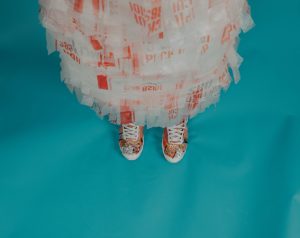By donating clothes to recycling projects, textile waste can be reduced to protect the planet. Innovative projects are running to support both business and the environment.
In my last blog post, I wrote about sustainable fashion brands. Many of them use creative techniques to contribute to environmental protection. With this week’s blog post, I want to follow up on that. So I asked myself: What is the most effective way to protect the environment. Number one on the list, of course, is to be naked. That is hardly possible today. So I came across recycling. But what does recycling mean? I am sure everyone knows these bins where you can drop off old clothes. But do you know what is behind the whole process? Me neither! So I did some research and found some insights, which I am going to share with you in this blog post. If you are interested in recycling and want to find out how you can protect the environment a little by supporting recycling projects, this blog post might be interesting for you!
What does recycling mean?
Let’s start with the definition of recycling. Recycling means returning waste from consumption or production processes back into the economic cycle. Waste is processed so that it can be reused in the manufacture of a new product (Farwer, 2018). Accordingly, recycling in the fashion industry means collecting and processing shoes, garments, and fabric remnants so that they can be reused to manufacture new pieces (Leblanc, 2019). So let’s have a closer look at the process of fashion recycling. First of all, people must become aware of the importance of recycling. The key to this is, of course, communication. The next step in the recycling process is the collection of textiles. In 2018 a total of 55,483 tonnes of textiles were collected in Switzerland (BAFU, 2019). Probably the best-known method of collecting clothes is to place bins in public spots where people can throw in their old clothes. After the clothes are collected, they must be sorted. This is done either manually or automatically by a machine. Automated sorting is supported by the Textiles for Textiles (T4T) initiative, which allows a higher degree of recycling of clothing. The third step in recycling is processing. There are different techniques in processing textiles, depending on the composition of the materials. The right technology and the necessary expert knowledge is required for this (Leblanc, 2019). If you want to learn more about it, please click here.
Business opportunities
I was curious about how recycling can be turned into a business. There are already many companies that use intelligent technologies to recycle clothes, shoes, and fabric remnants into raw material that can be used to make new clothing. However, this requires a lot of expertise and investment in technology. If you now remember the three steps of recycling, which are described above, you might recognize that also other actions contribute to recycling. Many well-known fashion labels like The North Face, Patagonia, and H&M are therefore committed to collecting textiles. The so-called take-back programs not only help them to polish up their reputation but also generate financial profits. By rewarding customers with vouchers, discount codes, or a free garment for returning old clothes, customer acquisition, loyalty, and sales can be increased (Wicker, 2019). The reGain app has a similar concept. reGain app is a platform where you can donate old clothes in exchange for discount coupons from retail partners. People can either drop off their clothes directly at the charity shop, send them off, or have them picked-up at home. reGain app is based in the UK and works together with the British Red Cross. Unfortunately, the service is currently only available in the UK. Another great concept is realized by Mud Jeans, a brand for denim. The “lease a jeans” concept allows customers to rent a pair of trousers instead of buying them. The customer is charged a monthly rental fee for this. As soon as the customer returns the jeans, they are recycled and then rented or sold again.

What can you do?
Are you also interested in helping to protect the environment from the waste of the fast fashion industry? You can either choose the traditional way and throw your old clothes into one of the publicly accessible bins. You can bring your old clothes to H&M and Zara fashion stores. At H&M, you can even get a small discount on your next purchase. And Zara is currently developing a pick-up service for old clothes via its online shop. Or you can support a great project like “lease a jeans” by Mud Jeans and rent your next pair of jeans instead of buying them.
What do you think about recycling in the fashion industry? Or do you know other great projects? I would love to hear about it in the comments section below.
Sources:
Bundesamt für Umwelt BAFU. (2019). Abfallmengen und Recycling 2018 im Überblick. Retrieved March 28, 2020 from https://www.bafu.admin.ch/bafu/de/home/themen/abfall/zustand/daten/abfallstatistiken-2018.html
European Commission. Eco-innovation. When business meets the environment. Retrieved March 28, 2020 from https://ec.europa.eu/environment/eco-innovation/projects/en/projects/t4t
Farwer, L. (2018, September 9). Recycling: Eine Definition. Focus online. Retrieved March 28, 2020 from https://praxistipps.focus.de/recycling-eine-definition_97702
Leblanc, R. (2019, February 27). How Clothing Recycling Works. Sustainable Businesses. Retrieved March 28, 2020 from https://www.thebalancesmb.com/how-garment-recycling-works-2877992
Wicker, A. (2019, August). Fashion’s growing interest in recycling clothing. Retrieved March 28, 2020 from https://www.voguebusiness.com/companies/fashion-brands-recycling-upcycling-resale-takeback-sustainability




Hi Anja, great article! I’m not quite sure what I think of H&M’s conscious collection and their recycling program. On the one hand, it’s great they’re trying, but given their size and overall environmental impact, they could be doing a lot more – same goes for Zara. For me, my own personal strategy has been to steer clear from the fast fashion industry as much as I could and instead go for longer lasting items from brands I trust more.
Hey Olivier, thank you so much for your comment.I agree with you, but I think it’s a start at least. But you’re absolutely right, they could definitely do more. I like your strategy! You might be interested in my next posts. I will now focus a little more on second hand fashion-